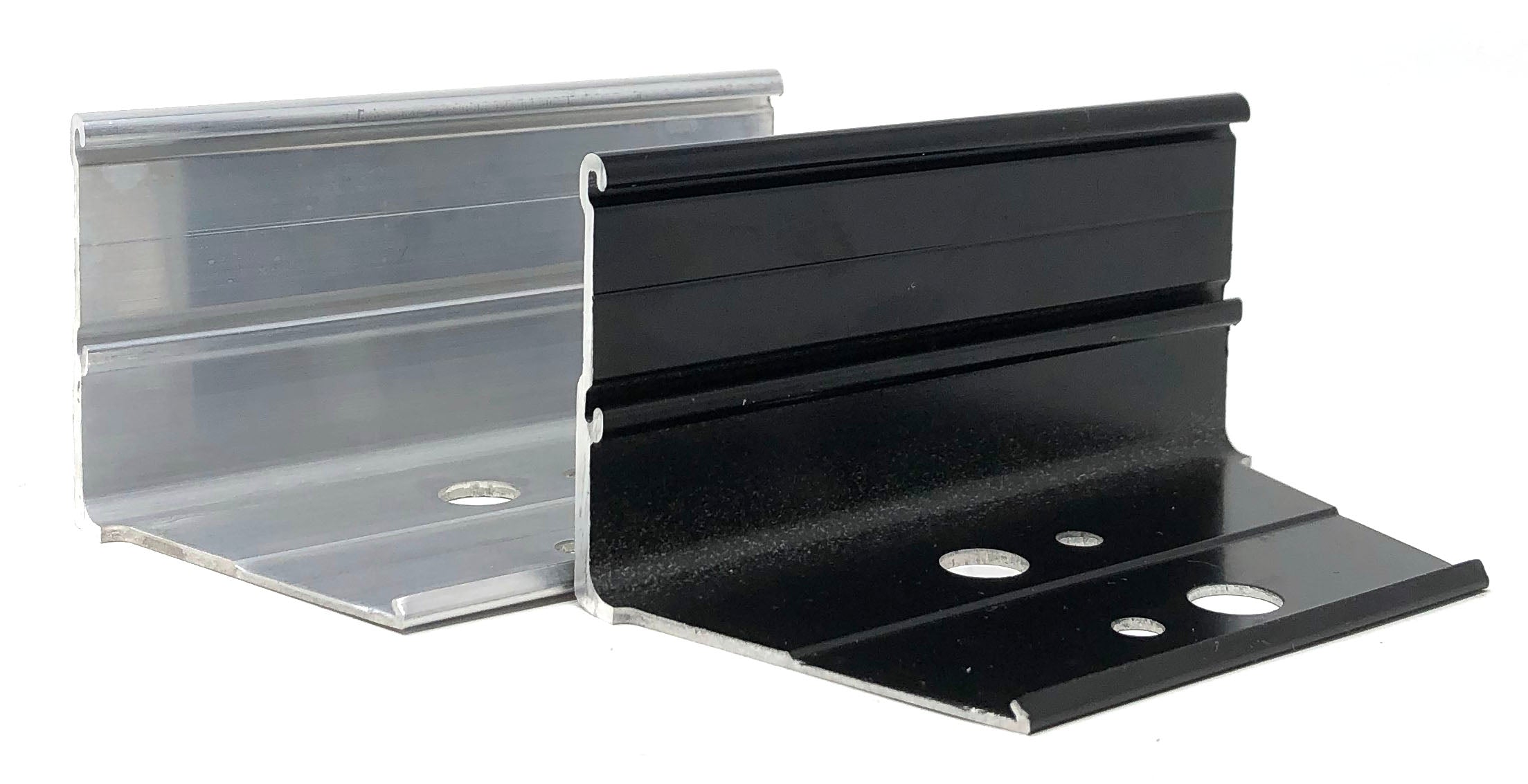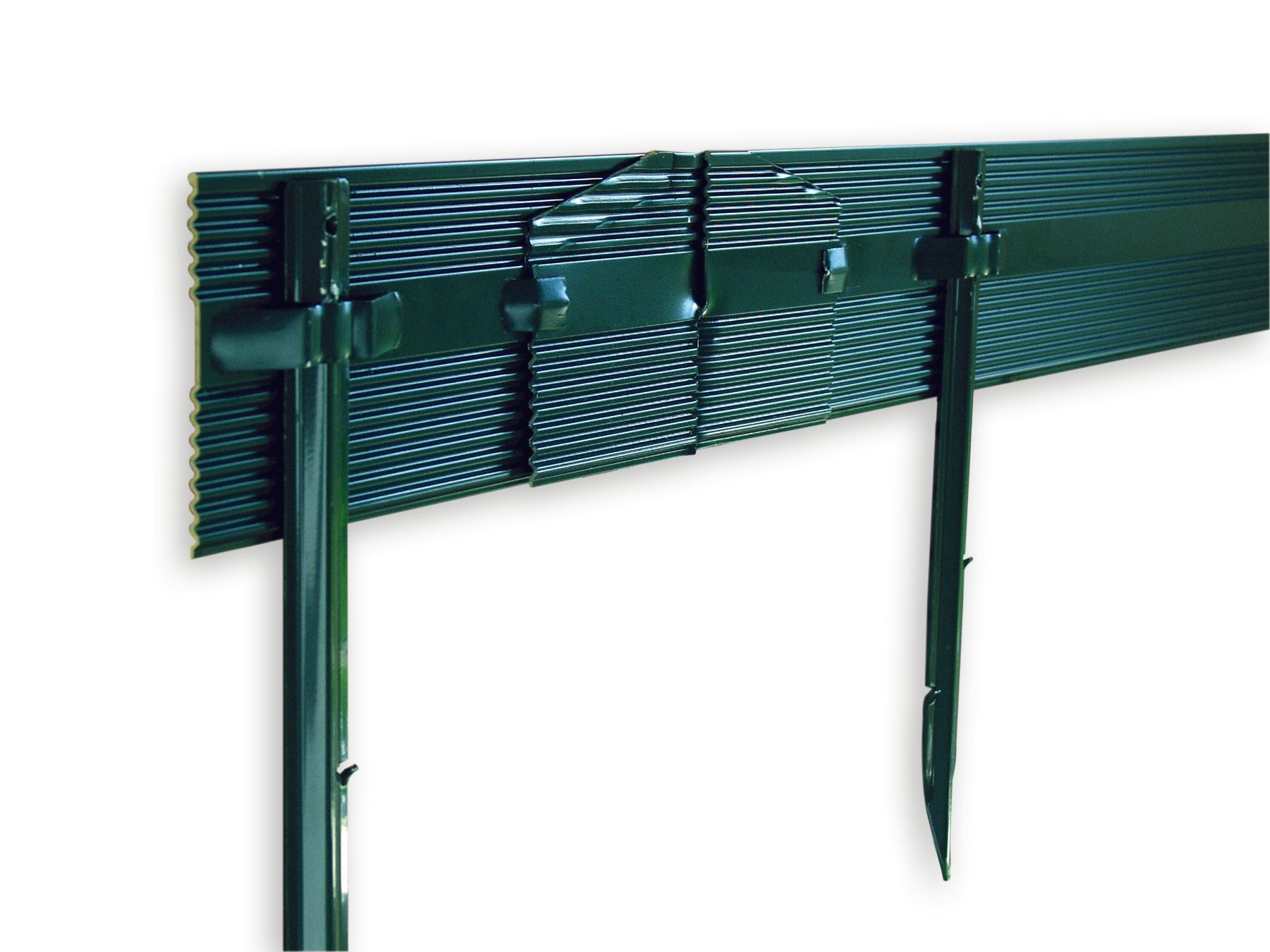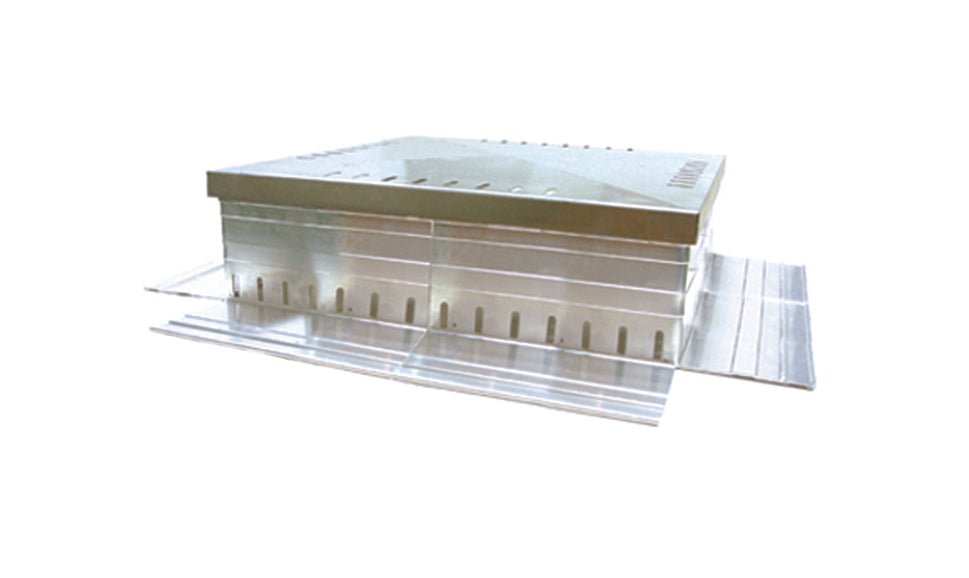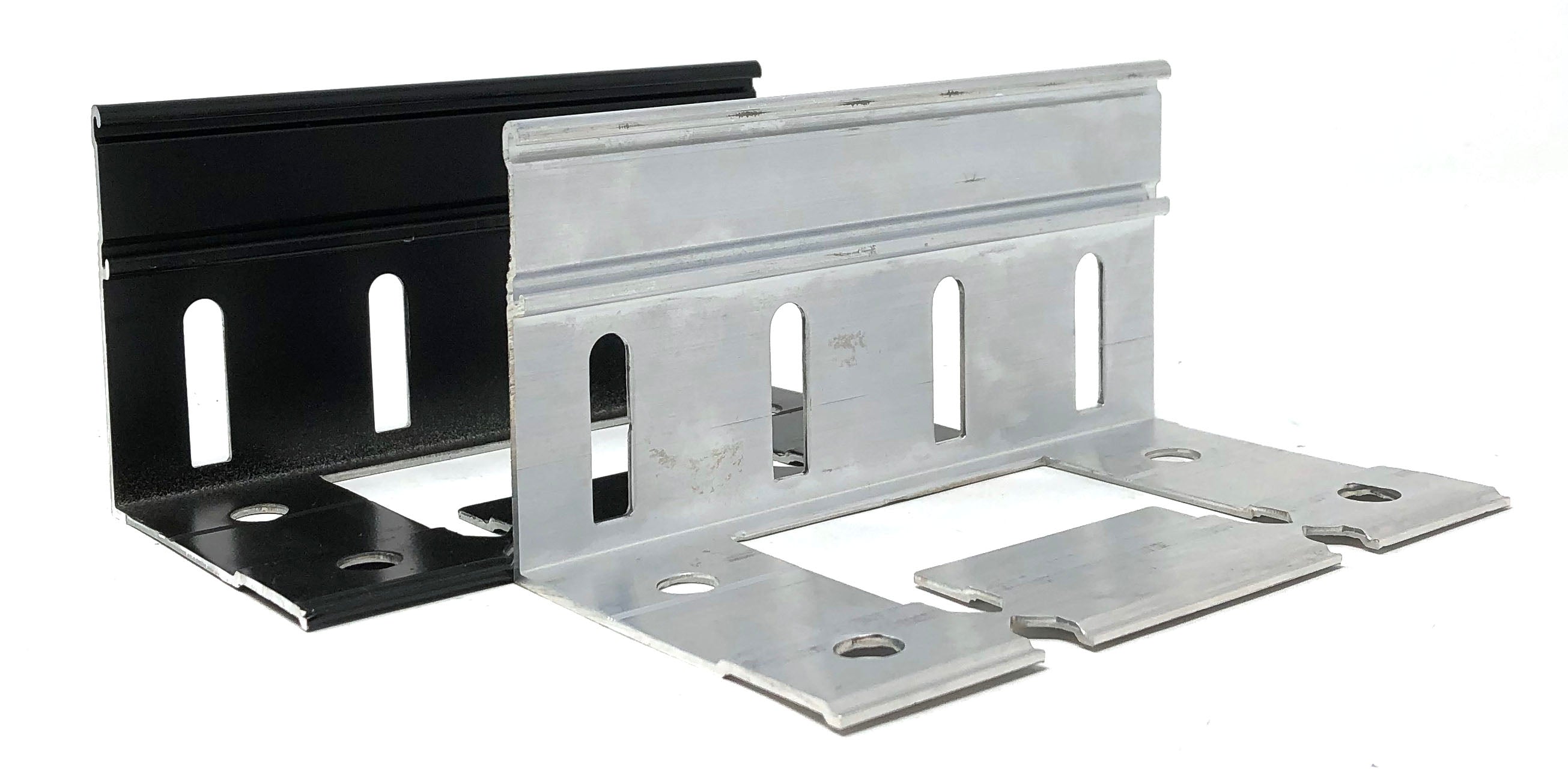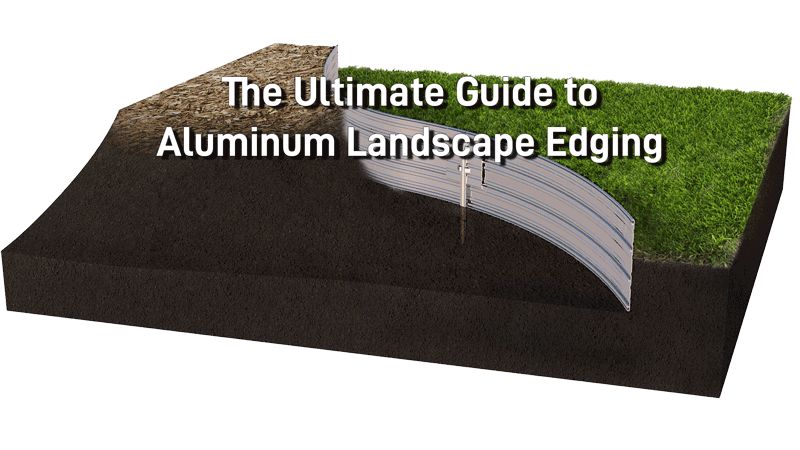The Ultimate Guide to Aluminum Landscape Edging

Permaloc aluminum landscape edging cut section
Aluminum edging is one of the most popular landscape edging materials nowadays for a lot of good reasons. Landscapers and homeowners love aluminum landscape edging because it is sleek-looking and durable. It also unfailingly keeps gardens and lawns in check and these qualities make it the perfect tool for creating and maintaining landscape features such as trees, shrubs, flower beds, paths, and driveways.
Aluminum landscape edging is a long-lasting strip of aluminum used to edge the borders of gardens, paths, driveways, and more. It keeps soil and rocks from becoming displaced, and it can prevent plants from creeping over the edge.
If you are looking for the right material to retain mulch, soil, rocks, or concrete on your lawn, then look no further. Aluminum landscape edging will leave your plants looking well-maintained, your lawn and garden looking chic, and your wallet happy. So, if you want to know more about why aluminum is the best edging material, read on because we have got you covered.
What Is Aluminum Landscape Edging?
Aluminum landscape edging is a thin strip of aluminum installed at the edge of a landscape feature to keep all of the stones, soil, mulch, plants, or concrete within it from eroding. The edging also supports plants' growth and prevents any weeds from getting into the edged area. Landscape edging, especially metal landscape edging, also creates straight, fine lines between areas of land, making your lawn or garden aesthetically pleasing.

Aluminum Landscape Edging before and after
When rain, wind, and freezing temperatures impact your landscape features, they can erode and crumble under pressure from the weather. Metal landscape edging is a great way to prevent your mulch and soil from getting washed away by the rain, and it is the best tool for keeping stones and concrete in place.
Aluminum landscape edging does not just prevent surface erosion. Still, it prevents soil from eroding underneath concrete and stone paths, driveways, and other structures. So, suppose you want to keep your concrete and stone paths and walls safe from erosion. In that case, you might want to have some aluminum edging installed along their sides to prevent them from washing away or cracking in cold conditions.
Aluminum edging is a great tool to fight erosion, but it also keeps creeping plants such as grass, vines, and weeds from growing beyond the area that the edging protects. So, suppose you want to keep your plants growing within a particular plot of land or want to keep weeds from climbing into your garden bed. In that case, aluminum edging can help you maintain order on your lawn.
Many people also prefer aluminum landscape edging for its sleek, sharp look. It can divide outdoor spaces into sections with fine lines that do not draw too much attention to themselves. They can also be used for asphalt driveway edging to give clean even borders for your project. Other materials can be bulky, which detracts from the appearance of your lawn or garden. Aluminum also takes up less space than wood, stone, or concrete, which will allow you to give your plants all of the room and attention that they deserve.
Metal landscape edging is particularly advantageous because it will not degrade, crack, or chip like stone, wood, and cement. Aluminum edging does not corrode or rust either, making it last much longer than any other landscape edging. It is also impervious to cold and wet weather, so it is one of the best edging materials available.
When you mow your lawn or whack weeds, you do not want to be worried about destroying your landscape edging. Aluminum edging is so durable that you can use a weed whacker on it, and it will suffer little damage. Still, thinner aluminum edging may get dents or scratches from hard wear. However, since aluminum is so flexible, these dents are very easy to fix with a rubber mallet.
Different Types of Aluminum Edging
Aluminum landscape edging comes in long, thin strips that are custom cut to fit the area you want to install them in. The strips usually have a width of between 3-5 inches (7.6-12.7 cm) so that you can choose any width that you prefer. Generally, taller edging is better for concrete and stone features or large plants like trees. Shorter edging is usually better for flower beds and small areas.
Most aluminum edging comes in different thicknesses too. Thinner options will be easier to ding and dent, but most of the time, it takes quite a bit of force to damage the aluminum.

Landscape Edging

Asphalt Edging

Hardscape/Architectural Edging
More often than not, aluminum will just dent or bend, even if you drive over it with a car. It is pretty easy to fix these dents or bends. All you need to do is use a mallet or your hands to bend the aluminum back in place. Still, if you are worried about the durability of ¼ inch (0.64 cm) aluminum edging, you can always get a thicker one.
Some aluminum edging comes with stakes, but others require the installer to dig a trench and pack the metal down into the soil. How your aluminum edging is installed depends on the type that you buy, so you should always consult with a professional installer before trying to put it in yourself.
There are several types of aluminum edging, each designed for a specific purpose. Some are better at retaining soil, and others are better at reinforcing cement, rock, and brick. Choosing the right type for your landscaping project will ensure that your edging does its job right for a long time.
Corrugated aluminum edging, which has a distinct wavy pattern, is particularly good at keeping soil in a garden or flower bed. Usually, grooved edging is less wide than the other types. Thus, it is most commonly used for smaller features like gardens.
Permaloc edging has small brackets along the bottom of the metal where stakes will keep it firmly rooted in the ground. This type of border is excellent at keeping heavier materials, such as stone, brick, and concrete, inside your plot but is still ideal for retaining mulch and soil.
Some aluminum edgings are designed to be more flexible than others. These flexible materials are perfect for edging circular or irregular-shaped landscape features. Since they are so bendable, they do not require any deliberate hammering or shaping to coil around the wavy corners on your land.
Some aluminum edging has two layers of metal to retain more landscaping material. These form a double-barrier to prevent soil, stones, and plants from creeping outside the border effectively.
The wide variety of widths and types makes aluminum a versatile edging material. Choosing from all of the variations will allow you to more easily edge anything from small features like mailbox posts to more extensive features like ponds and driveways.
Aluminum is a marvelous edging material that comes any way you could want it. However, before you buy your edging, you should always consult with your installer to decide which type will work best for your landscaping project.
How Long Does Aluminum Edging Last?
Aluminum landscape edging will last you a lifetime as long as it is installed correctly and does not suffer any hard-wear damage. Generally, aluminum stays shiny and solid for at least 50 years, even when exposed to harsh weather. Still, it has been known to last over 100 years. Aluminum is one of the longest-lasting edging materials. Investing in it and a knowledgeable installer will surely pay off in the long run.

Because there is no steel or iron in aluminum, it will never rust. Since it does not rust or corrode, aluminum will never get brittle and chip away as steel does. So, suppose you are interested in keeping your landscape features looking clean and neat for a long time. In that case, aluminum edging is the way to go.
Aluminum lasts a long time because it oxidizes differently than other metals. When aluminum is exposed to oxygen, it forms a thick, hard layer of aluminum oxide. Once aluminum oxide covers the edging's entire surface, the oxidation process will stop since the metal is no longer exposed to oxygen. Aluminum oxide is more rigid than raw aluminum, so you will not need to worry about your edging breaking down over time.
The only time that aluminum edging can get damaged is if someone installed it incorrectly. Sometimes, when the aluminum edging is not installed by a professional, it can get damaged by mowers, weed whackers, and even foot traffic. Aluminum is likely to bend if you do not reinforce it correctly.
You can install most aluminum edging by burying the bottom of the metal in a trench. Once the aluminum's bottom edge is staked into the ditch, the installer refills it with soil. After installation, you should make sure that only 1/2 inch (1.3 cm) of the aluminum's top edge is exposed above the soil's surface.
Many people install their aluminum edging in too shallow of a trench, especially in areas with a land-level height differential. If you do not install the metal correctly, it can quickly become damaged. To ensure that it lasts a long time, you should have a trusted professional install the edging for you. If you want to install it yourself, you should do thorough research on the specific type of edging you want to install.
How to Install Aluminum Edging?
If you install aluminum edging improperly, it will not last as long as it should. Knowing how to install your aluminum landscape edging is essential, even if you just want to know how to make your edging last as long as possible.
The following steps will help ensure your edging is securely in place and will last the life of the project.

Picture Credit WikiHow
- Measure the area that you will be edging carefully. Make sure to use a flexible measuring tape to ensure that you take all of your land's irregularities into account. Once you have measured the area, you might want to draw up a diagram to make purchasing your aluminum edging easier.
- Once you have your aluminum edging, you will need to dig a trench that the aluminum edging can sit in. Measure your aluminum edging's height, and then subtract ½ inch from the total height. You will need to dig your trench to this depth so that ½ inch of the metal is all that is exposed.
- Dig your trench. Using a shovel or trowel, depending on the size of the area that you are edging, dig a narrow ditch around the whole perimeter. Periodically measure the depth of the trench to ensure that it is just deep enough for your edging.
- Once you have made your trench, place the edging into it. Sit your edging within the groove, leaning it towards the outer edge of your plot. Make sure to put all of the edging pieces into your trench now to ensure that you have the right length of edging. If you need to bend the aluminum, use gloves to stretch the aluminum over a brick. Once you have the right angle, put it in the trench.
- If your edging came with stakes, use a rubber mallet to stake them into the dirt. You should angle every other stake towards you and then away from you when you put your stakes in the aluminum. If you change every other stake's insertion angle, they will create extra tension in your edging, making it stronger and straighter.
- As you drive each stake into the ground, pack some dirt down into the bottom of the trench. Tightly tamping the soil as you stake will also help you keep the edging straight as you work your way around the perimeter.
- Once you have staked your landscape edging down, it is time to fill in the trench. Rake the soil back into the ditch, and pack it down with your foot or a tamper to pack the dirt as tightly as possible. The tighter you press the soil in, the stronger your aluminum edging will be, so stomp away!
You may need to repack the soil for the next few weeks to ensure that none of it washes away or comes loose
DOWNLOAD FULL INSTALL GUIDE HERE>

How To Cut Aluminum Edging?
Cutting aluminum is a lot easier than cutting other metals. Most aluminum garden edging is thin enough to cut on your own without any special tools. All you will need to cut aluminum landscape edging is a pair of gloves, and a hacksaw.
Before cutting the metal, you should mark the area you want to cut with a pencil or permanent marker. To cut the edging, hold the aluminum away from your body and use the hack saw to cut off the aluminum piece that you want to remove. If you want to soften the sharp edge of your edging, use a pair of pliers to fold the outer edge inward, creating a rounded, dull edge.
Suppose you want to install the edging on a sharp corner. In that case, you may want to cut the aluminum to make the installation easier. When you saw the aluminum to make a corner, saw a straight slit in the edging that goes about halfway down. If you are installing your edging on a hilly area, you may want to cut out a small v-shape to compensate for the height difference. Next, take a brick or table and carefully bend the aluminum to make a sharp, angular corner.
What’s the Difference Between Aluminum Edging and Steel Edging?
Aluminum is a lot cheaper, longer-lasting, more flexible, and easier to install than steel.

Aluminum edging installed on residential lawn

Steel edging installed with a time-worn patina
The most apparent difference between steel and aluminum edging is the way that they look. Aluminum is a shiny, white metal that does not rust. It does not develop a patina, either, so it will stay polished and shiny forever. However, steel does rust quickly, and it will turn a reddish-brown color not too long after you install it.
Aluminum, unlike steel, does not rust. Steel breaks down over time because oxygen exposure damages it. There are some sealing paints and varnishes available to protect steel landscape edging from the air. Still, you would need to reapply these protective products frequently to keep the steel from rusting. Sealing steel can be a costly process, and it is time-consuming. Aluminum, however, does not require a sealer to stay strong.
On the same token, steel is practically impervious to rough wear. You can run over steel with your car, run a mower over it, or even take a chainsaw to it, and it will not break. Still, steel becomes brittle over time, making it easier to break as it ages. Usually, steel will start to rust and chip away around 20 years after installation. But the rate at which the steel rusts depends on the steel's composition and how it is treated.
The flexibility of aluminum makes it a popular edging material for self-installation. Aluminum edging is easy to cut, bend, and install, and it does not require any special tools to install. Overall, aluminum is much easier to install than steel, making it an excellent material for anyone who wants to try installing the edging on their own.
Aluminum is usually a lot cheaper to install than steel since it is lighter and much more flexible. Carrying long strips of steel is a tough job. Steel also requires special tools and sometimes welding to cut, making the installation of steel edging a lot harder, more time-consuming, and potentially more expensive. Aluminum, however, is a lightweight material that can be carried, cut, and bent easily.
Aluminum is also a lot more environmentally-friendly than other materials such as steel. Did you know that over 65% of the aluminum that we use every day has already been recycled once? It is one of the most recyclable materials, which means aluminum edging is made from recycled aluminum. Also, you can recycle any old aluminum edging and any scraps from your landscaping projects.
What Makes Aluminum Better Than Other Edging Materials?
When it comes to landscape edging, aluminum takes the prize for the best choice. Still, you might wonder why aluminum is better than other materials. Well, that is why we have researched for you.
Some of the other commonly used edging materials are wood, stone and brick, and plastic. Suppose you want an easy answer to why aluminum is the best out of all of these materials. In that case, aluminum lasts the longest and is the most weatherproof.

Wood landscape edging
Wood
Naturally, wood is one of the quickest edging materials to degrade. Wood does not do well in areas with a lot of rain or humidity because fungi are prone to growing on damp wood. Even treated woods are not immune to fungal growth. Since wood breaks down so quickly, you would be lucky if your wood edging lasts ten years.
When using wood as an edging material, you also have to be careful about the kind of wood you use. Some treated woods, like railroad ties, have been covered with antifungals that will kill plants. Other boards that are untreated will rot very quickly.
Wood is also not the best material for curvaceous or irregular-shaped areas. Because wood is usually straight, you will have to cut a lot of wood to make an effective barrier. Even then, you can only make curves by cutting the wood into short, angular segments. The limits of wood's rigidity can make installation difficult and time-consuming. Using wood edging will never result in a seamless, smooth line.
Stone, Bricks, and Pavers
On the other hand, stone, bricks, and pavers handle humidity very well, unless the rain washes away the dirt from under them. When rain and harsh winds move the soil on your land, the earth beneath paved areas can quickly erode, causing the stone and brick paving to crack. People commonly use aluminum edging to strengthen stone edging because the aluminum keeps the soil from washing out from beneath the stone and brick.

Brick flower bed edging
Unlike aluminum, stone, brick, and pavers are not immune to the cold. When there is water trapped in brick or stone, it can freeze in cold conditions. If the water freezes, the whole surface of the stone or brick might crack and crumble away. But if you live somewhere that gets freezing temperatures often, you might want to pass on the rock and brick and go with aluminum instead.

Plastic landscape edging
Plastic
Plastic is relatively weatherproof, but exposure to light makes it brittle and easy to crack. Over time, the sun's ultraviolet rays will cause the plastic to degrade, so you would have to replace plastic landscape edging every few years. Plastic edging may be cheaper than any other option, but in the long run, it will end up costing a lot to keep replacing it.
Plastic also is not as aesthetically pleasing as aluminum. Edging made from plastic can often be painted or finished to look like another material. However, the patterns and finishes can be quickly bleached by the sun or washed off by wet weather. Most of the time, plastic looks cheap, and since it can become damaged easily, leaving unsightly holes and cracks in your edging.
Overall, aluminum landscape edging is one of the best materials, if not the absolute best material, for edging lawns, gardens, and other landscape features. Aluminum lasts longer than steel, wood, stone, brick, pavers, and plastic, and it is easy to install. It is also more flexible than most edging materials, making it perfect for any landscaping project.
Conclusion
Aluminum landscape edging has made a massive comeback in recent years. It is so popular because it lasts a long time, has many different uses, looks beautiful, is easy to install, and is relatively inexpensive.
Aluminum edging has so many applications that it has become a staple for many landscapers and homeowners. So, suppose you want clean, chic edging for any landscape feature. In that case, aluminum is a foolproof edging solution that is always appropriate.
Permaloc Aluminum Edging Options:
Resources:
- Wiley Metal: Aluminum Corrosion
- Lehigh County Department of Waste Management: Aluminum Recycling
- Total Landscape Care: Choosing the Best Type of Edging
- RopaRoofing: How Long Does A Metal Roof Last
- Hunker: How to Install Metal Lawn and Landscape Edging
- Reliance Foundry: Stages of Rust
- The Spruce: Best Lawn Edging Materials
Jake Goodwin
Customer Support
Jake is member of the customer support team and lends his expertise to the Longview blog. Jake can be reached by emailing Support@longviewsupplycom

